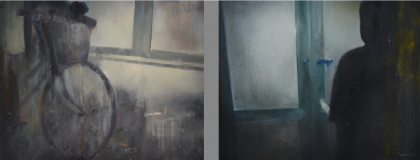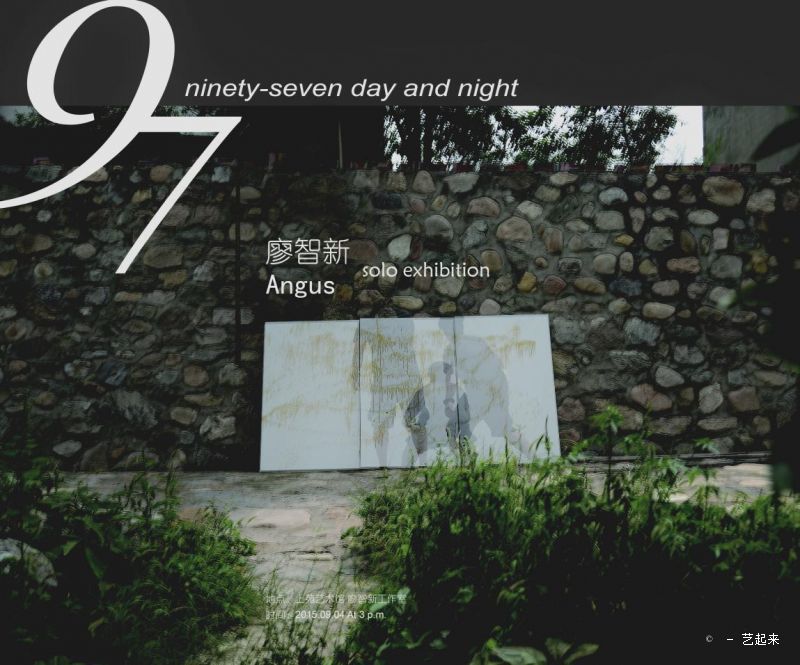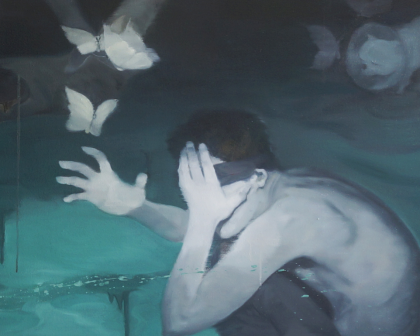


译:覃奕恺|Kyne
Everybody has stories. Some people write them, some people dream them, some people take them to their grave. Liao Zhi Xin paints his stories. “97 days and nights”, the length of time Zhixin spent at the Shangyuan Modern Art Museum residency program in Beijing, is a collection of his visually rich new narrative paintings.
每个人都有属于他的故事。有的人写下他的故事,有的人把故事寄托在梦里,有的人用一辈子去追求自己的故事。而廖智新画出了属于他的故事。 97个日日夜夜,是廖智新花在北京上苑现代艺术馆驻馆创作计划上的时间,这也是他用丰富的视觉语言描述出来的故事。
Looking as Zhixin's paintings is like watching some 1940's Hollywood film noir where the action is expressed as much by the interplay of light and inky darkness as it is by the character actors. In “12:45, 6th August” (the titles of these paintings are the dates and times the canvases were worked on, or completed) a black silhouetted figure is crunched against the right side of the canvas, flashlight in hand. The edge of the figure is defined by the glow of light coming from behind a glass door, its blue latch momentarily caught in the beam of the flashlight. The set up could either be malevolent or mundane, a burglary or someone returning home late. “11th July Comeback” presents us with a figure adrift in some murky pond, and though blindfolded his hands are raised to repel the intense beam of light pointed at his face. The palish yellow white paint is scraped and pulled suggesting the fluidity of light blinding the scene. Edges of the figure in the penumbra are beautifully drawn, those in the intense light are almost indistinct. A small stroke of pink perfectly describes the ear poking below the blindfold. There appears to be reference to photographic sources in Liao's paintings, but he is not interested in honoring that source with washy renderings. Liao is interested in paint and how the paint can carry the narrative. This places him firmly in the category of figurative painters that include Jerome Witkin, Lars Elling and Neo Rausch.
观看廖智新的作品恍如鉴赏上世纪四十年代的好莱坞悲情片,其笔墨光影如此动情,是戏角淋漓尽致的表演。《8月6日,12点45分》(作品之名皆以画作起笔或完成的时刻命名)画面右侧压抑的黑色身影手里提着电筒,将挂着蓝色锁闩的玻璃门照亮的那一瞬间,光芒又照映出了他的轮廓。此景令人遐想,是入室行窃,还是回家太晚?《7月11日,回》展现了一个混浊池塘里的漂流者,即使眼睛已经被蒙蔽,他仍挥手抗拒着直射到脸上的强光。苍白又泛黄的画面被剐蹭被拉扯,暗示着场景中炫光的流向。半个身影的形象刻画得甚是美妙,在强烈的光线下几近虚无,眼罩下一撮粉红色所点缀的小耳垂又把整个人物完美地立体化。廖智新的作品似乎取景于一系列实景照片,但他对无脑还原画面效果这种行为并不感兴趣。相比之下,令廖智新思考更多的是以何种绘画的言语方式进行叙述。而这,使他在如美国艺术家杰罗姆.威特金,挪威艺术家拉尔斯.艾琳以及德国艺术家尼奥•罗施之流的(寓意画派figurative painters)中据有一席之地。
“June11 – July 24 <studio>” is a multipanel train wreck. Literally. Three 160cm x 100cm panels form the central part of the narrative. Train cars upended and crumpled occupy the top right hand corner of the triptych, their steely grays emerging from an ominously gray sky, then dissolve into aggressive darkness. Two prone figures are bathed in a pool of light, a ribbon of red and white hazard tape snakes across the bottom, visually and figuratively tying the panels together. The hazard tape motif continues along the right hand outside edge of the painting, and is echoed on the left hand outside edge of a much smaller canvas set slightly apart to the right. This smaller 80cm x 100cm canvas is a post script of sorts. The light here is reversed. Two diminutive dark figures in dark uniforms lurk in the chaos and the box shape train cars glow in a morning light. The size difference and placement of the imagery forces the viewer to view them sequentially, as if a cinematic cut, or the gentle unrolling of a Chinese landscape scroll.
“6月11日- 7月24日《画室》” 是一幅三联的失事列车残骸,可以从字面上理解。160cm X 100cm的三联画构成了叙事的主体。顶部可以看到,火车车厢被翻倒、挤压折皱。充满凶兆的灰暗天空赋予了它们灰铁的颜色,而后融入了不安分的黑暗中。两个倒下的人物被光笼罩,红白相间的危险隔离带如蛇一般穿过画面底部,从形象到意向将三幅画面连接起来。隔离带仍在右侧画面之外延续着,与一旁稍小幅画框的左侧相呼应。这幅较小的80cm X 100cm作品也许是个故事的后记,光芒在此颠覆。两个穿着黑色制服的矮小暗影潜伏在混沌中,车厢被晨光照耀着。诡异的对比和隐寓的画面布置使观众们因此而驻足,仿佛这是个电影桥段,亦或是中国山水画的幽幽展现。
There is a calligraphic ease to the way that Liao uses paint. The viscous trail of drips and the troweled and scraped areas of thick paint are done with spontaneity and control. The lines are drawn with an effortless ease that comes from the muscular memory of handling a brush from childhood writing lessons. In Liao Zhixin's complex visual narratives there is no obvious moral tale, no guarantee for a happily ever after ending and the paint is the main protagonist.
廖智新选择以画缓心(缓心而画),颜料滴滑而下的轨迹和厚重画面的刮铲,皆是有意为之又自然而然。轻松自在的线条来自手持笔刷时少儿笔画课留下的挥手记忆。 在廖智新复杂的视觉叙事手法中,没有任何道德说教,也不保证有什么幸福结局,只有画面是主角。
马赛克 Christopher Pelley
北京 Beijing 2015
作者介绍:
Christopher Pelley(马赛克)出生于美国纽约,艺术家以及艺术评论家,生活在罗马与北京。

联系我们